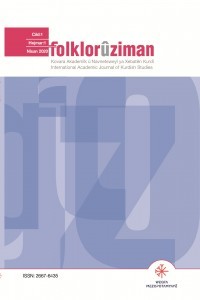Nirxandina Kurteçîrokên Mela Mehmûdê Bazîdîyî yên bi Navê Durru'l-Mecalîsê
Nirxandina Kurteçîrokên Mela Mehmûdê Bazîdîyî yên bi Navê Durru'l-Mecalîsê
The topic of this study is some of the short stories written by Mela Mehmûdê Bazidî in Kurdish (kurmanji dialect) are registered as Durru’l-Mecalis in the Jaba’s collection. In this article, after the presentation of the stories we try to evaluate them from the view point of sources as well as topic. Also, the information about the life and work of Mela Mehmûd was given and evaluated according to the available sources. Although Bazidi has placed Persian texts alongside Kurdish translated texts, it appears from the entire text that he collected some of these stories from the people of the Kurdish madrasas and recorded them there. As can be seen from the texts of Durru’l-Mecalis written by Mela Musa Hakari and from the stories told by mollas among people, these Bazidi stories are also closely related to folk tales. Bazidi does not even name any Persian source. Because the teachers of the Kurmanji madrasas have given importance to the Persian language and literature, in this study Bazidi also wrote the short stories in both Persian and Kurdish (Kurmanji idalect).
Keywords:
Durru’l-Mecalis, short stories, folk tales translation, comparative analyisis,
___
- Aslan, M. (2019). Baqek ji Folklora Berîya Mêrdînê. Îstanbul: Wardoz.
- Bazidî, M. M. (2010). Cami'eya Risaleyan û Hikayetan bi ZImanê Kurmancî (Amadekar: Ziya Avci). İstanbul: Lîs.
- Bilbil, M., & Oztirk, M. (2019). Rêzimana Mela Mehmûdê Bazîdîyî: Tuhfetu’l-Xîllan fî Zimanê Kurdan. İstanbul: Weqfa Mezoptamyayê.
- Botî, M. E. (1940). Şêr û Gayê Zer. Hawar, 8.
- Bülbül, M. & Öztürk, M. (2020). Destnivîska Mela Mistefa ya Rahênanên Zimanê Kurdî (Nirxandin, Metin). Folklor û Ziman, 117-140.
- Celalî, M. (2016). Mela Mehmûdê Bazidî. Kürt Tarihi, 7.
- Celîl, C. (2018). Çıma Deve Xeyidi? Amed: Wardoz.
- D. Îzolî, F. K.-T., & Tirkî-Kurdî, (. K. (2013). Ferheng: Kurdî-Tirkî;Tirkî-Kurdî, (Amadekar: Kamer Beysulen). İstanbul: Weşanên Deng.
- Dorson R. M. (1963). "Current Folklore Theories", Current Anthropology, 4(1) 93-112.
- Dost, J. (2010). Mela Mehmûdê Bayezidî, Adat û Rusûmatnameê Ekradiye. İstanbul: Nûbihar.
- ‘Emîd, H. (1389). Ferhengê Farisî ‘Emîd, (Wîrastar: ‘Ezîzullah ‘Elîzade). Kitabşinasê Millî.
- Farqînî, Z. (2000). Türkçe-Kürtçe Sözlük. İstanbul: İstanbul Kürt Enstitüsü.
- Gulî, M. X. (2002). Ferhenga Gulî (Farisî-Kurdî). Hewlêr: Wezareta Perwerdê.
- Huseyn, E. R. (2013). Mu‘cemu’n-Nefaisi’l-Esasî, (Îşraf: Ehmed Ratib ‘Irmuş). Beyrut: Darunnefais.
- Öztürk, M. (2017). Koleksîyona Aleksandre Jaba ya Destnivîsên Kurdî. Diyarbekir: Weşanên Lîs.
- Rûmî, M. C. (2015). Mesnewî (Wer. Mela Ahmedê Şerefxanî). Konya: Weşanên Çandî ya Şaredarîya Konyayê.
- Veroj, S. (2007). Dadgehîkirina Serokkomar Qazî Mihemed. Dîyarbekir: Weşanên Bîr.
- Xoşnaw, H. (2019). Durru’l-Mecalis: Yekemîn Komele Çîrok le Mêjûy Pexşanî Kurdî- Wergêran da. Hewlêr: Çapxaney Hêvî.
- Yildirim, K., Aslan, M., & Pertev, R. (2013). Ji Destpêkê Heta Niha Folklora Kurdî. Mardin Artuklu Üniversitesi Türkiye'de Yaşayan Diller Enstitüsü Yayınları.
- ISSN: 2667-6435
- Başlangıç: 2020
- Yayıncı: Mezopotamya Eğitim Bilim Sanat Sağlık Ve Kültür Vakfı İktisadi İşletmesi
Sayıdaki Diğer Makaleler
Temamkirin di Kurmancîyê da: Alîyên Semantîk-Tîpolojîk, bi Perspektîfeka Herêmî
Yaron MATRAS, Çevirmen: Ümran ALTINKILIÇ, Çevirmen: Sinan GÜLTEKİN
Kitabê “Avesta Dili ile Kırmancca (Zazaca)’nın Karşılaştırılması: Etimolojik Bir İnceleme” Ser o
Nirxandina Pirtûka “Kûçikê Daleqandî”yê
Zêmarên Kurdî yên Kafkasya û Herêma Mêrdînê: ji Hêla Teşe, Naverok û Zimanî ve
Analîza Çîroka Mihemed Begê Spîvanîyê li gor Çar Fonksîyonên Folklorê yên William R. Bascomî
Nirxandina Kurteçîrokên Mela Mehmûdê Bazîdîyî yên bi Navê Durru'l-Mecalîsê
